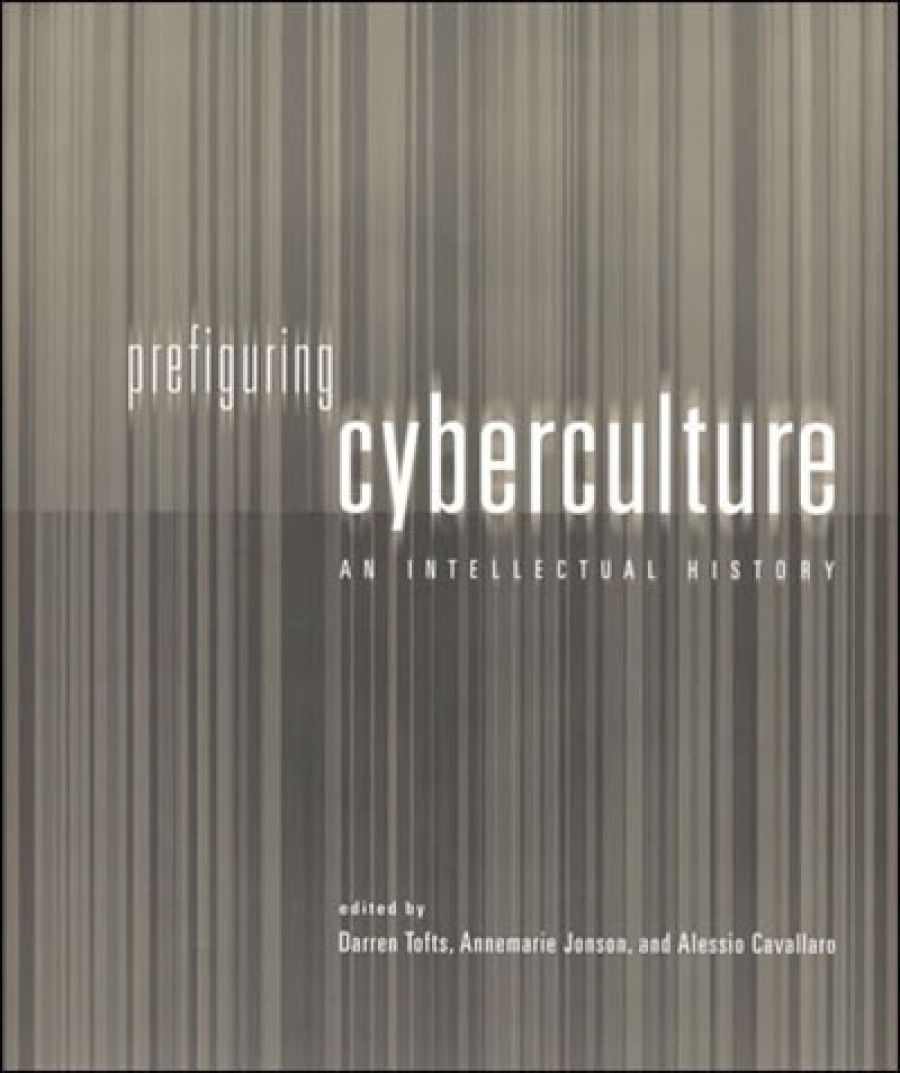
- Free Article: No
- Contents Category: History
- Review Article: Yes
- Article Title: Mimesis of What?
- Online Only: No
- Custom Highlight Text:
Many people regard cyberculture as the territory of boffins, sci-fi enthusiasts, and ‘itinerant wanderers’, and inescapably limited to computer technology. However, the term is also applied to a field of research, one that has always been interdisciplinary: traversing philosophy, mathematics, physiology, biology, linguistics, cognitive sciences, physics, and sociology. Prefiguring Cyberculture: An intellectual history exemplifies this cross-disciplinary approach.
- Book 1 Title: Prefiguring Cyberculture
- Book 1 Subtitle: An intellectual history
- Book 1 Biblio: Power Publications, $54.95 pb, 322 pp
Delivered as essays, the nodes in history – from the seventeenth century to today, with speculations on tomorrow – are woven through ‘“framing texts” drawn from fiction, science and philosophy’. Most were ‘selected on the basis of their recognised importance in debates to do with cybercultural discourse’. These texts include Alan Turing’s ‘Computing Machinery and Intelligence’, Plato’s ‘Simile of the Cave’, René Descartes’s ‘Meditations’, Donna Haraway’s ‘Manifesto for Cyborgs’, and Philip K. Dick’s ‘Man, Android, and Machine’. The notion of using seminal texts as a springboard, advanced by Alessio Cavallaro five years ago, ensures that the discussions are anchored for the new media novice, promotes a unique elucidation for the scholarly, but, more importantly, demonstrates how cyberculture was anticipated before the new technology.
The contributors are astutely chosen for their sage-like interpolations: Donald F. Theall, Zoë Soufoulis, Gregory Ulmer, Margaret Wertheim – and the list goes on. Each explores the movements and stagnations of many disciplines, with a common thread identifying them as investigators into human life. Their style is varied: some indulge in marked divergences from the assigned texts; others forge persuasive arguments around them. The editors are local identities with international reputations. Joint publication with MIT Press attests to the volume’s seriousness and timeliness.
The collection is divided into four sections. The first, ‘I, Robot: AI, ALife and Cyborgs’, is a discourse on the history of the search for consciousness. A driving belief – that reality, or life, can be understood and captured if it can be replicated – is observable in the writers, engineers, mathematicians, theologians, and theorists considered in this section.
‘Virtuality: Webworlds and Cyberspaces’ addresses reader-reception, interface design, grammatology, and memory, among other things. It reviews past conceptualisations of the virtual and offers alternatives in light of the blurring evident in human-computer interactions. Through examinations of literature, we are guided towards witty axioms, such as McKenzie Wark’s: ‘If virtual reality is mimesis, then mimesis of what?’
In the third chapter, ‘Visible Unrealities: Artists’ Statements’, ten new media practitioners are given the space to discuss their own experientially informed response to many cyber theory concerns. Australian artists Troy Innocent, Stephen Jones, Jon McCormack, V.N.S. Matrix. and Stelarc are among the virtuosos. The artists are vouchsafed only one page to comment on the essayists’ theories and to describe their research interests. This insufficient allocation led me to question the function of this section of the book. But it will provide the uninitiated with a rationale behind the artists’ projects.
The final section, ‘Futuropolis: Postmillennial Speculations’, is concerned with how the future has been imagined, indeed prophesised, by an analysis of the works of Francis Bacon, Samuel Butler, Vernor Vinge, Arthur C. Clarke, and others. The contributors differ in their visions of the future, its framing within a technological paradigm, and observations of present-day society. The approach of these essayists – initiated by Donna Haraway in her call ‘for pleasure in the confusion of boundaries and for the responsibility in their construction’ – has produced rich and provocative exegeses.
The collection is not an exhaustive overview, nor was it intended to be. Although the greatest hits of cyber theory are addressed (cognition, memory, intelligence, the virtual, space, interactive design, representation, perception, reception, non-linear narrative), not all the practitioners are covered. For instance, Evelyn Fox Keller, in ‘Marrying the Premodern to the Postmodern: Computers and Organisms after WWII’, discusses Norbert Weiner and cybernetics, but only briefly addresses the developments in studies of organisation. But all the pieces offer an excellent selection of references at the end, and the footnotes are useful.
I found it ironic that non-traditional textual works (like hypertext fiction) are rarely referred to. Catherine Waldby’s articulate reading of Mary Shelley’s Frankenstein, in ‘The Instruments of Life: Frankenstein and Cyberculture’, does not refer to the highly successful and much studied hypertext fiction about a female Frankenstein monster by Shelley Jackson: Patchwork Girl (1995). This is understandable, given the brief and focus of the essays, but the exclusion is nonetheless curious and disappointing. The intention behind focusing on conventional texts to the exclusion of others can be read as an attempt to redefine all texts as hypertextual; to make the point that cyberculture was intimated a long time ago. It does, however, suggest that new media works are still not – despite their presence for over two decades – deemed worthy of the retrospective overview of cyberculture’s path.
These observations should not discourage potential readers of Prefiguring Cyberculture, for it is a sophisticated and lucid guide to how we have arrived at a ‘culture’ that is prefixed with a term denoting its transience. The essay format allows the reader an insight into many of the antecedents and, importantly, the effect they have had on current noetic approaches.


Comments powered by CComment